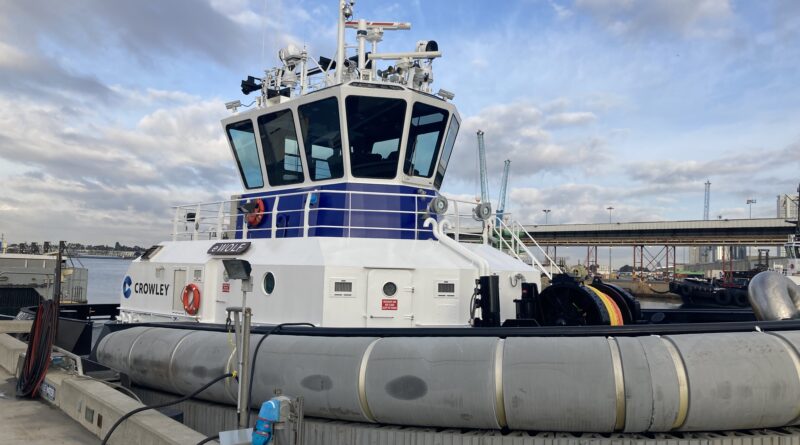New Electric Tugboat Unveiled At Port Of San Diego
The Port of San Diego recently unveiled its new electric tugboat, the eWolf. The electric tugboat runs only on electricity, whereas a conventional tugboat uses diesel fuel. The new electric tugboat generates no carbon dioxide or unhealthy air pollution such as particulate matter.
Air pollution at ports is a well-documented problem. The US EPA website has a Port Primer explaining some of the key air pollution details, “Reducing pollutants from diesel engines is a significant concern for ports and near-port communities. Equipment, vehicles and marine vessels that burn diesel fuel are the primary source of combustion-related emissions at port facilities. Pollutants released by diesel engines include particulate matter (PM), nitrogen oxides, (NOX), carbon monoxide (CO), sulfur oxides (SOX), and air toxics.”
Replacing diesel tugboats with electric ones is an effective way of reducing harmful air pollution at ports.
The electric tugboat at the Port of San Diego was manufactured by Crowley Maritime Corporation.
Here are some specs:
Length: About 78 feet at the waterline
Beam: 40 feet
Depth: 17’ 9”
Thrusters: 2 x Azimuthing Thrusters
David Decamp, Corporate Communications Director at Crowley, answered some questions about the electric vessel for CleanTechnica.
What are the size of the two motors?
2 x 2,100 kW electric motors
What is the size of the battery system?
6.2 MWh
What is the battery chemistry?
Corvus Orca Energy battery information is available here. Corvus Orca ESS – Corvus Energy
On that page, it references the battery cell chemistry, which is: Lithium-ion NMC / graphite.
How long can the electric tug be operated between charges, and about how long to charge?
It will do a full day’s work, generally two jobs, and can be charged in six hours or less. The charging station will be connected to the grid, and utilize off-peak charging as well as have solar power supplementing the grid-supplied energy.
You can find more information on the eTug at crowley.com/etugs
Approximately what are the fuel savings from using electricity instead of fossil fuel?
eWolf replaces a conventional tug that currently expends 31,000 gallons of diesel per year. Over the first 10 years of use, eWolf will reduce:
- 178 tons of nitrogen oxide (NOx)
- 2.5 tons of diesel particulate matter
- 3,100 metric tons of carbon dioxide (CO2)
 Chip in a few dollars a month to help support independent cleantech coverage that helps to accelerate the cleantech revolution!
Chip in a few dollars a month to help support independent cleantech coverage that helps to accelerate the cleantech revolution!
Is the electric tug more powerful than its gas counterpart?
The conventional tug is not gas, but diesel.
“The eWolf offers even better performance than the conventional tug, providing more power and offering technology to help mariners operate the tugboat more efficiently and safely. The eWolf offers substantially more bollard pull at 70 tons, versus 55 or less from the conventional tugs in San Diego,” said Paul Manzi, vice president, Crowley Shipping.
Is it expected that the electric tug will have less maintenance and repairs than a diesel-powered tug?
We expect eWolf to help reduce maintenance and related costs over time thanks to modular technology, more efficient systems, and reduced use of fuel products and engine maintenance. While the exact reduction and savings will be realized over time, we can anticipate a significant reduction in operating costs over the 10-year span.
Is the plan to eventually replace all the gas tugs with electric ones?
We will be working with our partners in West Coast ports to identify sustainable and viable opportunities to use eTugs or hybrid variants in line with the operational needs and air quality goals in those locations.
Is the electric tug quieter than a diesel tug?
It is very much quieter, which is a significant added value for mariners, reducing noise as they work and improving environmental safety.
What is the eTug’s cost?
As a private company, the cost for the first-of-their-kind electric tug and its charging station being completed is proprietary. We can tell you we have received strong support from these partners for both the vessel and the charging station:
▪ San Diego Air Pollution Control District (#556436): $2,794,400
▪ San Diego Air Pollution Control District (#565124): $8,112,785
▪ Environmental Protection Agency): $2,017,660
▪ Maritime Administration MARAD Cooperative: $750,000
Total Grant Funding: $13,674,845
Image credit: Crowley Maritime Corporation
Have a tip for CleanTechnica? Want to advertise? Want to suggest a guest for our CleanTech Talk podcast? Contact us here.
Latest CleanTechnica.TV Videos

CleanTechnica uses affiliate links. See our policy here.

